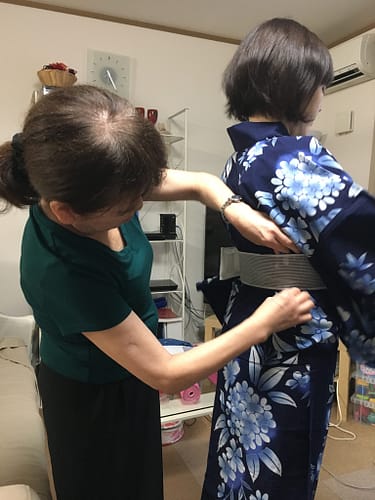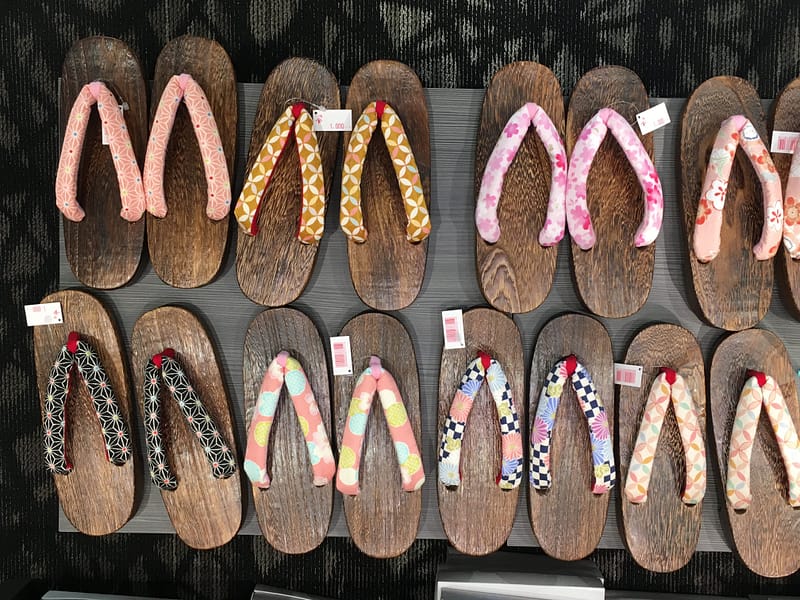“Be brave. Take risks. Nothing can substitute experience.” – Paulo Coelho
It’s a Saturday in July (a little late, I know), and I have received an invite from Ayumi, a Japanese friend of mine. She asked me to go with her to a matsuri, or festival, in her area of town. It was a small, local neighborhood gathering with food vendors and people crowding the tiny streets. I’m sure there was a reason for the festival, but I’m not sure what it was.
As part of the festival, she suggested we don traditional yukatas. Although it resembles a kimono, the two are different and serve different purposes. A kimono, usually for formal occasions, is often made of silk. Made of cotton or linen, yukatas are traditionally put on after a bath to keep cool. (Think of them as a cross almost between a robe and pajamas). The lighter fabric makes them more breathable and casual – perfect summer wear. Lately, they have been making quite a fashion statement throughout Japan. Thanks to large clothing companies, like UNIQLO, yukatas are gaining popularity here and in neighboring countries.
Neither Ayumi nor I knew how to properly dress a yukata, so her mother helped us out. Although there are rules to follow, yukata styling is more fluid than that of a kimono. For example, the left side of the yukata always goes on top when wrapping yourself. To fold the opposite way, leaving the right side on top, is only for burial practices and is generally regarded as a bad omen.
Step by Step – Dressing in a Yukata
Donning a yukata has many steps. First, I put on a wide piece of fabric, with spots for the arms already defined. Ayumi’s mom folds and ties the yukata at my waist, using a koshi-himo, a thin strip of cloth. Here, the fabric is adjusted according to the wearer’s height. At the waist, the fold is either pulled lower for shorter people or let out for taller wearers. Next, an obi-ita is added. This is a stiff belt that goes over the folded yukata fabric. It helps the obi sash lay flat and it feels a lot like boning in a prom dress.


Then, an obi is chosen to complement the colors of the yukata. The obi is tied decoratively at the back, usually in a bow, but can also be folded and tucked in. Lastly comes the obi-jime, a thin, decorative rope to go on top of our obis. Great care is needed to ensure the wrapping and tying is symmetrical and lying flat. The last step is the geta sandals, traditionally made of wood. I tried on a pair that was entirely too small (just my toes went in), so my Chaco sandals had to suffice.
As a final touch, Ayumi tied my hair in a pretty up-do, secured with a kanzashi, a chopstick-like hairpiece. It is common to see women in yukatas with their hair pulled up and off the nape of their neck. It makes for an appealing style, as well as helps to keep the wearer a bit cooler. After a few photos, we were off!


To The Festival!
Walking to the festival was slightly challenging and slow. The length and tightness of the yukata restricted my stride, meaning smaller steps and a slower pace. I was glad I wore leggings underneath so I could take a little less care in how I walked and sat. Don’t worry, I was still careful not to have my yukata accidentally open above the knee.
The heat didn’t stop the community from coming out in full force. There were food vendors, dancing, and people everywhere! Lots of younger girls and teenagers were wearing yukatas. One woman stopped me and complimented me on the styling and tying of my outfit. She asked if I tied it myself, and I laughed a bit inside as I told her no.
Ayumi and I tried takoyaki, a round snack made of wheat flour and typically filled with octopus. It surprised me that the sight of tentacles protruding from the ball didn’t totally turn me off. Luckily, there wasn’t much inside and it blended well with the dough. I did my best to not overthink what I was eating and overall it was pretty tasty.


We stayed out for a bit before ending up at a local restaurant for a snack. I’ll be honest, I’m surprised that I didn’t receive any negative looks or stares at the festival. Clearly “I’m not from here”, and I expected some giggles and double takes. But people didn’t seem to think twice about a foreigner wearing traditional dress.
From my experience, the Japanese people seem to be very accepting and open to visitors and this time was no different. While I don’t know how often I’ll wear a yukata in public, I was glad for the experience.


